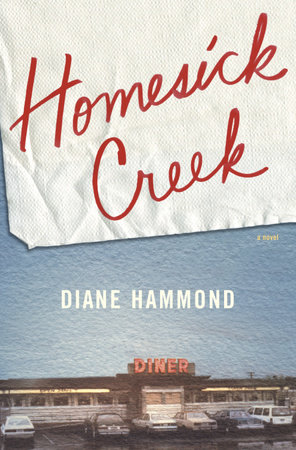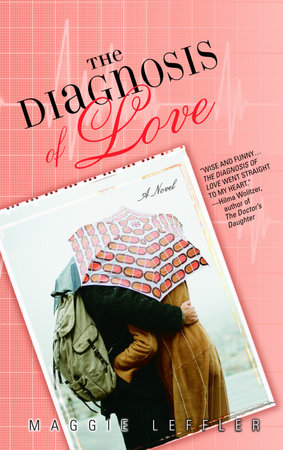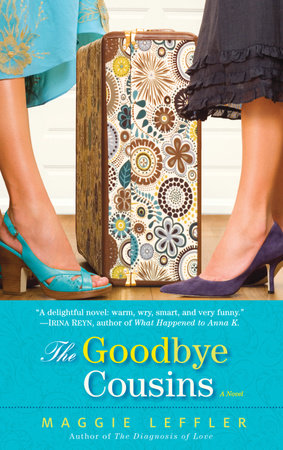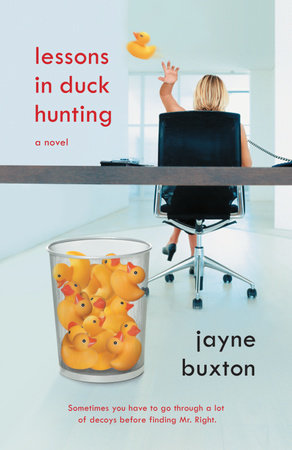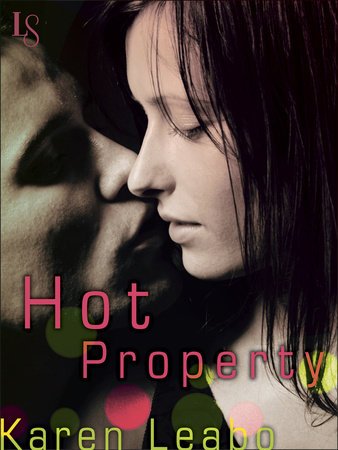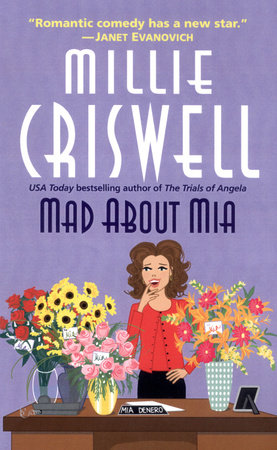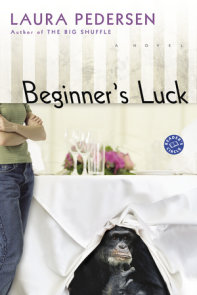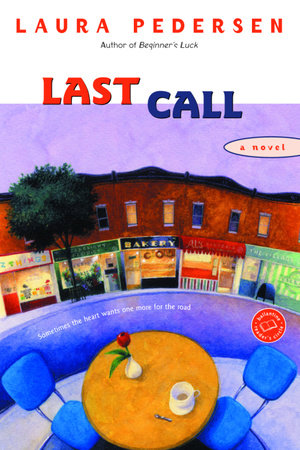Author Q&A
A Conversation with Laura Pedersen
Julie Sciandra and Laura Pedersen have been friends since their potato salad days as teenagers during the energy crisis in Buffalo, New York, back when you had to keep moving in order to stay warm.
Julie Sciandra:Where exactly is Cosgrove County?
Laura Pedersen:Well, how do you want to go there—by car?
JS: Say that I want to drive there from Buffalo, New York.
LP: That’s easy. You get on the thruway going west, drive through a chunk of Pennsylvania, and eventually you’re in the northeast corner of Ohio. Get on Route 45 heading south. After about twenty minutes you’ll see a dairy with a big plastic cow on top and a faded red barn behind it—make a left at that corner. Go through the covered bridge—it’s a shame about the graffiti, but it does make you wonder whatever happened to those couples, especially the ones who declared True Luv 4ever. Drive about two more miles, until you see the old mill where they sell apple cider and maple syrup, and then bear left at the fork in the road. Only slow down because a lot of Amish folk live around there and they don’t like to use those orange triangles on the back of their buggies. They also don’t care to have their picture taken. But if their farm stand is open you definitely want to stop and buy a cherry pie—absolutely delicious. Anyway, after approximately three more miles you’ll come to the edge of town. There’s the train station and then the park. If you make a right onto Millersport it will take you up to Cappy’s place.Otherwise go left on Swan Street and that takes you to Main.Main Street is about eight blocks long and you’ll know you’re at the end of it when you pass the town hall and see the gravel road that leads to the cemetery. On a nice day the cemetery can be a great place for a picnic. I actually prefer it to the park.
JS: So this town is a real place?
LP: It is to me. But then I’m an only child and we’re known for creating not just imaginary friends but entire galaxies.
JS: Throughout the first three Hallie Palmer books you make it sound as if the town has been hurt by the advent of outlet centers and superstores.
LP: Cosgrove has certainly known its ups and downs, like so many towns in Middle America. Back in the 1800s the land around there was a good place for a farmer to settle, since the soil is rich and you had not only the railroad nearby for transporting your crops but also the Great Lakes. The Erie Canal was completed in 1825, and so your grain or lumber or whatever was sent by train to Buffalo and then got loaded onto mule barges that went past Albany on the Hudson River, to New York City, and could then go on to Europe. Similarly, after the transcontinental railroad was completed in 1869, your goods could be easily transported to Chicago and the fast-developing Plains, Rockies, and California.
JS: Do you want to start singing “Erie Canal”?
LP: “Low bridge, everybody down. Low bridge, for we’re coming to a town.”
JS: Did you have to sing that in elementary school as many times as we did?
LP:More. Sweet Home is a public school.
JS: I’d forgotten that the name of your school system is Sweet Home.My condolences.
LP: It definitely caused more than a few fights. Our mascot was the panther, but at basketball games the opposing team liked to snarl, “Sweet Home Sweeties.” This didn’t go over real well. No matter, I’m just glad they finally got the asbestos out of the ceilings.
JS: So the town where Hallie lives was going gangbusters back in the 1890s.What went wrong?
LP: As farming became increasingly mechanized, people began working and living in town. But by the 1940s they’d started migrating to the cities for work in the factories, steel plants, stockyards, and granaries, at least until the 1950s and 1960s when many of those jobs went overseas. Then the oil crisis and recession of the 1970s hit the area pretty hard. However, this past year the town is becoming more of a bedroom community for Cleveland, and if they go ahead with those plans to start a commuter train it’s really going to revive things.
JS: And exactly how is it that you know all of this? Do you have a seat on the town council?
LP: Actually, I’m the town historian.
JS: Sure you are. Now back to the story. Do we finally find out the name of Hallie’s mom?
LP: No.
JS: The Big Shuffle seems darker than the first two books in the Hallie Palmer series.Has anything happened to make you more pessimistic since you wrote those?
LP: I don’t find it so, but then I thought Last Call—a love story between a roguish Scotsman living in Brooklyn and a nun who has run off from the convent—was optimistic when a good portion of that book was about dying from cancer. I tend to stick with the themes of life, love, and death. So basically in every book someone is going to get it. It was a greater tragedy because Hallie’s father is a relatively young man and leaves behind this enormous family. On the other hand, the Palmers have experienced plenty of new life, with a total of ten children, and so every once in a while the pendulum has to swing.
JS: But was it necessary to go that far for Hallie to become an adult?
LP: Good question. No, I don’t think anything was needed to help Hallie along, and that she was going to arrive on her own just fine. She didn’t have to be snapped into reality by a major event. I suppose I was harkening back to the past. There wasn’t really such a thing as “childhood” until about sixty years ago. Children were regarded as small adults. Furthermore, if you consider that back then the average life span was shorter, families were larger, and the number of women who died in childbirth was much greater, Hallie’s situation as temporary head of the household wouldn’t have been that unusual. In fact, I often think that teenagers today don’t feel all that challenged by their roles and fantasize about being able to do something heroic in a tough situation. I’m not advocating such circumstances, simply saying that most teens can and will rise to the occasion when put to the test, rather than just play sports, start rock bands, do homework, work at the Tastee Freez, and roam the mall. On the flip side, I know a lot of teenagers who do community service, whether it’s through school, a religious organization, or on their own, and this is a great way of learning about what type of adult they’d like to become.
JS: I’ve noticed that you seem to kill off at least one man in every novel?
LP: A few women have stepped on a rainbow—Denny’s wife in Going Away Party, Hayden’s wife in Last Call, and Pastor Costello’s mother was called home sometime between Heart’s Desire and The Big Shuffle. But you’re right to ask since these deaths occurred offstage and were more plot devices than the demise of developed characters. In my defense, Olivia takes a bad fall in Heart’s Desire and Hallie’s mom spends several months in a hospital during The Big Shuffle. Overall, you’re correct and I appear to be a man killer. Please don’t tell my husband.
JS:Where did Uncle Lenny come from? He must be one of your more bizarre characters.
LP: I think Uncle Lenny comes off as being eccentric only because he’s been temporarily transplanted to a small town in Ohio and we don’t encounter him in the port of Marseille. Which is what makes Uncle Lenny so much fun to have in the book—he has a different vocabulary from years at sea and is not familiar with typical suburban family life. However, he’s practical in the way that most sailors are, has a big heart, and ends up being an enormous help, which is more than we can say for Aunt Lala.
JS:Why is Bernard afraid to travel? Is that supposed to be symbolic in some way?
LP: I think we all have our fears, some more rational than others, some more acceptable or explainable than others. I never meant for it to be symbolic of anything. Bernard is just a home-and-hearth kind of guy and has hung on to that worry so many of us have when we’re young about going into the woods and not coming back. Or worse, a loved one leaving and not returning. Bernard feels that nothing bad can happen in the safety of one’s own home, surrounded by the people you love, aside from the occasional kitchen accident.
JS:What’s Hallie’s biggest fear?
LP: Aside from dropping one of those twins on his head, I guess it would be to make the wrong decision about something important—which man to marry, what job to take, where to live. I think that Hallie is in many ways overwhelmed by the amount of freedom she has to make choices regarding the direction her life will take. And that’s why she keeps circling her safe places—Officer Rich, the Stocktons, her family—always on the lookout for clear answers. To a good card player there’s almost always a right move—at least the odds favor it fifty-one percent and so you make it. But in real life the probabilities, decision trees, and possible outcomes can’t be calculated as accurately. This drives Hallie crazy, the fact that the world isn’t a math problem that can be easily solved with a pencil and paper. And that unlike work done with a pencil, life choices can’t necessarily be erased.
JS:What are you most afraid of ?
LP: Dying one of those long, slow, horrible deaths from a disease they don’t know much about, you can’t pronounce, and none of my friends have heard of, so between monthslong hospital stays I’m on the Internet searching for cures and ordering guava pulp concentrate from South America, lighting lavender candles, and forming healing circles with the dogs. I’d much rather the M4 bus come barreling up Madison Avenue on a winter day when there’s a bad glare and the curb is slippery and performs the Grim Reaper’s job lickety-split.As soon as the passengers look out the window and see that the driver has killed a woman wearing a fuzzy pink bathrobe and silver moon boots, they groan and immediately start shouting, “Give us a refund!” and “Is there another bus behind this one?”
JS: Good luck with that.Why is Best Bet, the next book, going to be the last in the Hallie Palmer series?
LP: At around the age of twenty-two I suddenly became very boring, basically the person I am today.
JS: So what’s next?
LP: I’m working on a stand-alone novel called Fool’s Mate which is a bit edgier than this series. It takes place in a newsroom and there are some political machinations, which I’ve mostly avoided in the Hallie Palmer books, aside from Olivia’s protests and editorializing. I’m also working on a new series where two women open an animal hospital in upstate New York. One is a veterinarian and the other has an MBA.
JS:Wait a second. That sounds like my life.
LP: It is. But I had the idea first. Remember—I showed it to you years ago when you lived in Manhattan and then you went and copied it with your life. Same with John and Kelly adopting a baby from China. They stole that from Heart’s Desire.
JS:Will a lot of men die in the next series?
LP: I suppose it depends on whether or not they’re good drivers. The winters in upstate New York are very icy.
JS:What’s your ultimate goal as a writer?
LP: Ideally, I’d like to get my books banned. That seems to be the best thing for sales.



